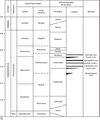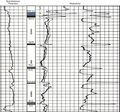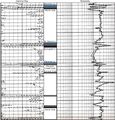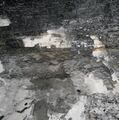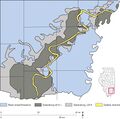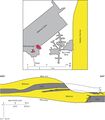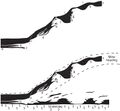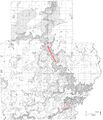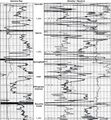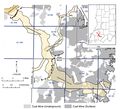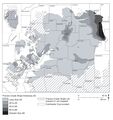Semantic search
Jump to navigation
Jump to search
- '''Figure 5a''' Wireline log illustrating the typical response of key units. (a) Electric log of Carter Oil No. 1 Beers well in sec. 28, T8S, R4E, Williamson County, Illinois (county no. 2107). B, Brereton Limestone; H, Herrin Coal; Sp, Springfield Coal; Han, Hanover Limestone; HC, Houchin Creek Coal; SV, Survant Coal; MQ, Mecca Quarry Shale; C, Colchester Coal. (b) Gamma-ray–resistivity log of Peabody Natural Gas No. 2 Short, in sec. 14, T7S, R7E, Hamilton County (county no. 25375).
- '''Figure 5b''' Wireline log illustrating the typical response of key units. (a) Electric log of Carter Oil No. 1 Beers well in sec. 28, T8S, R4E, Williamson County, Illinois (county no. 2107). B, Brereton Limestone; H, Herrin Coal; Sp, Springfield Coal; Han, Hanover Limestone; HC, Houchin Creek Coal; SV, Survant Coal; MQ, Mecca Quarry Shale; C, Colchester Coal. (b) Gamma-ray–resistivity log of Peabody Natural Gas No. 2 Short, in sec. 14, T7S, R7E, Hamilton County (county no. 25375).
- '''Figure 13''' Photographs showing the ragged, erosive contact between the light-colored siltstone of the Dykersburg Member and the underlying coaly shale of the Galatia Member in the channel crossing at the Galatia Mine, Saline County, Illinois. (a) View of the east wall of the entry. Coaly shale of the Galatia Member grades laterally northward (left, out of view) to shaly Springfield Coal. The pick is approximately 2 ft (60 cm) long. (b) Close-up view on the west wall of the entry. The heart of the Galatia channel is south (left) of view. Notice how erosion undercut the clay below layers of tough, fibrous peat.
- '''Figure 15''' Photograph showing rhythmic lamination in sandy facies of the Dykersburg Member in American Coal’s Millennium Mine, Saline County, Illinois. Enlarged view at right. Reprinted from Palaeogeography, Palaeoclimatology, Palaeoecology, v. 487, p. 74, W.A. DiMichele, S.D. Elrick, and W.J. Nelson, Vegetational zonation in a swamp forest, Middle Pennsylvanian, Illinois Basin, U.S.A., indicates niche differentiation in a wetland plant community. Copyright 2017, with permission from Elsevier.
- '''Figure 20''' Photographs showing the Springfield Coal “split” by massive siltstone in the Millennium Mine. The lower view is a close-up of the upper view. Notice the ragged splaying of coal layers into the siltstone from both above and below, with one coal stringer crossing diagonally from the lower to the upper coal “bench.” Combined with the absence of roots beneath the upper bench, such geometry implies that the upper part of the peat deposit was rafted. Enlarged view at right. Brown and yellow stains resulted from iron-rich water seeping through the coal.
- '''Figure 21''' Photographs of siltstone “splits” in the Springfield Coal. (a) Upper “bench” of coal splitting into multiple layers, with ragged splaying of lower coal layers at the Millennium Mine. (b) Contact between the upper coal bench and a massive siltstone split in American Coal’s Millennium Mine, approximately 0.6 mi (1 km) west of the main Galatia channel. Notice the complete absence of root traces in the siltstone.
- '''Figure 27''' (Top) Image of the major disturbance in the Wabash Mine. From Meier and Harper (1981). (Bottom) The same drawing with interpretation added, depicting the peat deposit torn asunder, with the upper part floated away from the lower. The seam height at the left side of the diagram is approximately 9 ft (2.7 m).
- '''Figure 34''' Maps of the Leslie Cemetery channel. (a) Regional map showing the relationship to other channels. (b) Map of the northern part of the Leslie Cemetery channel, with the thickness of the Folsomville Member. From Eggert (1984), The Leslie Cemetery and Francisco distributary fluvial channels in the Petersburg Formation (Pennsylvanian) of Gibson County, Indiana, U.S.A., in R.A. Rahmani and R.M. Flores, eds., Sedimentology of coal and coal-bearing sequences: International Association of Sedimentologists, Special Publication 7 p. 311, 313. Copyright © 1984 The International Association of Sedimentologists.
- '''Figure 36''' Generalized sketches illustrating opposite margins of the Leslie Cemetery channel, as exposed in surface mines in the eastern half of 9S, 4W, Warrick County, Indiana. The upper image is from Peabody’s Lynnville Mine in July 1983, representing the northern half of the channel. The lower image is from Peabody’s Eby Pit in June 1982, representing the southern half of the channel.
- '''Figure 37''' Interpretive diagram showing sequential development of the Leslie Cemetery channel. (a) The Francisco channel is eroded and filled with sediment, largely sand. (b) Springfield peat accumulates in swale left by the abandoned channel. (c) Flowing water reoccupies the channel during the later stages of peat accumulation. Peat encroaches from the margins as the channel migrates laterally. (d) A marine incursion drowns the region and deposits black shale and limestone. Channel filling inverts the topography because of differential compaction.
- '''Figure 46''' Disruption of the Danville Coal, with the seam “split” by a thick wedge of mudstone. Note the ragged splaying of coal into mudstone, with a thin coal stringer crossing diagonally from the lower to upper “bench.” The site is the box cut at a portal of the Prosperity Mine in Gibson County, Indiana.

